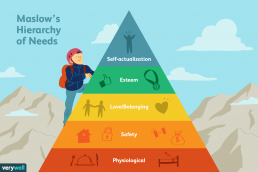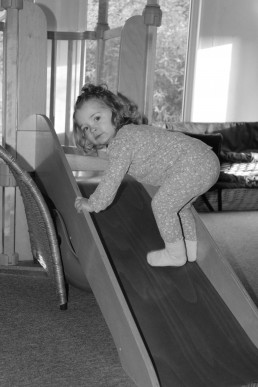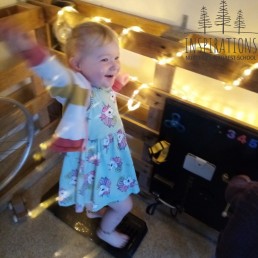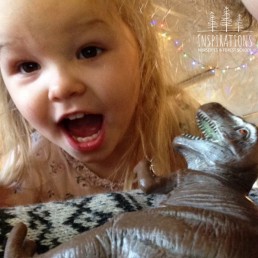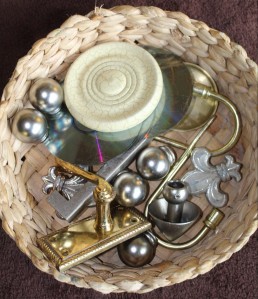Nursery Bag- What to Pack?
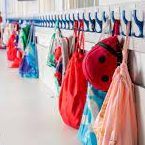
Up until now the only baby bag you've needed is your maternity bag filled with nappies, snacks and one of everything to cover all eventualities. But when it comes to starting nursery your baby will need their own bag to bring with them each day. It's that first possession that belongs to them, the start of being independent. So let's make this transition as easy as possible and give you a check list to make sure you're not forgetting anything in that all important nursery bag.
What to pack?
Every room requires something a little different, and we know there can be a lot to remember so here's a broken down list of everything you'll need in your child's nursery bag for each room.
Our Baby Rooms- Hedgehogs and Butterflies
- Bottle and Formula (we provide milk from 1 year old)
- Comforter e.g Dummy
- Sleep Sack (if needed)
- Waterproof coat or suit suitable for all conditions (We do have some waterproof trousers but for none walkers in particular padded suits are ideal)
- At least 2 sets of spare clothes and socks
- Spare bibs
- Appropriate/supportive footwear
- Wellies
Our Toddler Room- Honeybees
- At least 2 sets of spare clothes and socks
- A warm waterproof coat
- Water bottle
- Waterproof Trousers
- Wellies
- Spare Hat and Gloves
Our Pre-School Room- Ladybirds
- A water Bottle
- At least 2 spares of every item of clothing and socks
- Thick warm socks for Forest School
- Wellies
'Take care of the little things and the big things fall into place'.
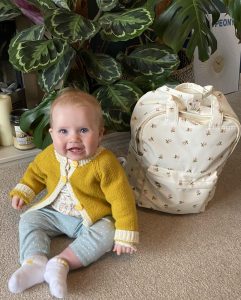
Transitions Within Nursery
Once that blissful Maternity leave you have just shared with your little one draws nearer to an end and the dreaded time comes to go back to work, beginning the transition process in to a Nursery, childminder or Nanny starts and it can be a big and daunting step for you and your little one. All sorts of emotions will come with this as you will no doubt be worried, sad, nervous, and anxious about leaving your child for the first time. However please be assured the settling in process supports you and your child to overcome these negative emotions and instead, make you feel happy, excited and reassured about this next milestone.
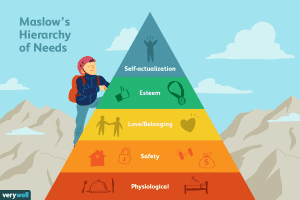 Young children starting a Nursery need support to enable them to adjust to a temporary separation from their family. Maslow’s Hierarchy of Needs demonstrates that children need to feel as safe, comfortable, and secure within the environment before they are able to move on to any other learning opportunities. Building a close bond with their Key Worker and the other Educators is particularly important so that they know they have someone to comfort them and make them smile when they are feeling a little sad. We aim to provide as much continuity and care as possible.
Young children starting a Nursery need support to enable them to adjust to a temporary separation from their family. Maslow’s Hierarchy of Needs demonstrates that children need to feel as safe, comfortable, and secure within the environment before they are able to move on to any other learning opportunities. Building a close bond with their Key Worker and the other Educators is particularly important so that they know they have someone to comfort them and make them smile when they are feeling a little sad. We aim to provide as much continuity and care as possible.
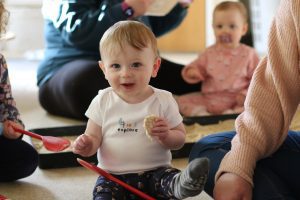 As children develop from birth throughout childhood this change involves a process for them to adapt their thoughts, feelings and behaviours to meet new expectations and even though this blog focuses on Transitions in to Nursery and between room bases, by the time they reach school age, they will more than likely of experienced more than just these transitions in their life. Depending on circumstances the child may be forced to attend more than one setting during the week and one of the big transitions they face is school. Next weeks blog will focus on transitions to school.
As children develop from birth throughout childhood this change involves a process for them to adapt their thoughts, feelings and behaviours to meet new expectations and even though this blog focuses on Transitions in to Nursery and between room bases, by the time they reach school age, they will more than likely of experienced more than just these transitions in their life. Depending on circumstances the child may be forced to attend more than one setting during the week and one of the big transitions they face is school. Next weeks blog will focus on transitions to school.
The Transition to Nursery is like a journey and takes time, preparation and planning. It is important to us that Parents and the Educators work together to make the process as smooth as possible.
The Procedure at Inspirations is as follows-
Under 2's
- A phone call is made to parents, by either the room leader or the Deputy room leader 4-6 weeks prior to the start date and a discussion is had to book in the home visit and settling in visits. It is also a chance to have a chat and ask any questions you may feel unsure about.
- Home visit 3-6 weeks prior to start date (applies to 2-year funded children also)
- Transition visits in to setting 1-2 weeks leading up to first day (1 x 1 hour with Parent, 1 x 1 hour on own and 2 x long visit (3-4 hours) over sleep and lunch or lunch and sleep depending on routine at time)
During these periods of settling in, we aim to share information and build up a picture of the child’s starting points, give a parent pack which will show pictures of the room they will start in along with pictures of the staff (identifying key worker and what their role is) and an overview of the daily routine. We give a parent handbook, check through paper work and talk about/document the routine they are currently following at home. We introduce their Key Worker and discuss any other information you feel relevant. It is also chance to speak about any allergies or dietary requirements
From 2-3 Years and Older
- A phone call is made to parents, by either the Room Leader or the Deputy 4-6 weeks prior to the start date and a discussion is had to book in the settling in visits. It is also a chance to have a chat and ask any questions you may feel unsure about.
- Transition visits in to setting 1-2 weeks leading up to first day (1 x 1 hour with Parent, 1 x 1 hour on own and 1 x long visit (3-4 hours) over lunch or tea
During these periods of settling in, we aim to share information and build up a picture of the child’s starting points, give a parent handbook, check through paper work and talk about, document the routine they are currently following at home. Introduce Key Worker and discuss any other information you feel relevant. It is also chance to speak about any allergies/dietary requirements
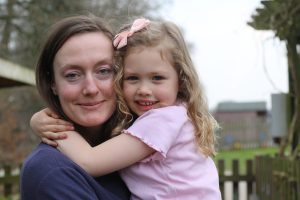 The procedure for room transitions is the same however, the conversations and planning happens between the Room Leaders, and the Key Worker attends the first visit with them. The Key Worker completes a transition form and takes this through on the first visit, this indicates starting points for the child and any other information that needs to be passed on.
The procedure for room transitions is the same however, the conversations and planning happens between the Room Leaders, and the Key Worker attends the first visit with them. The Key Worker completes a transition form and takes this through on the first visit, this indicates starting points for the child and any other information that needs to be passed on.
The impact of our procedures has shown us that the time given for them to settle in before starting is more than sufficient and during this time they have began to familiarise themselves with the environment and the Educators, in particular their new Key worker. However, if there is a chance it hasn’t gone as planned, we can offer additional support by allowing more settling in visits.
All this ground work to ensure smooth transitions helps create the right environment for your children to become confident little leaners here at Inspirations.
“If children feel safe, they can take risks, ask questions, make mistakes, learn to trust, share their feelings, and grow.” ~ Alfie Kohn
-Ashleigh
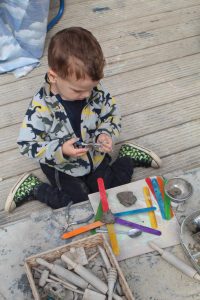

Measured Risks- Part 2
In our previous blog 'Risky Play' https://inspirationsnurseries.co.uk/risky-play/ -we defined the importance of risky play with the pre-school age group, but how can we incorporate measured risks within our youngest rooms?

Physical Risks and Emotional Risks
At Inspirations Nurseries and Forest School we are committed to outdoor play adventurous and creative play. Taking risks isn't a negative; it is about learning to safely manage tasks. Risky play can often be physical, but also includes taking emotional risks such as conquering fears and meeting new friends, and mental challenges such as learning a new routine or overcoming a fear.
 We work with our parents to find out each child's ability and how they are challenged. During home visits and settling in sessions we get to know the families and can usually determine whether the parents take measured risks themselves. At nursery, the educators will be aware of children's limits and which children need more support than others. Babies begin to take risks as soon as they begin exploring the world and their environment through crawling, rolling, walking, running and balancing.
We work with our parents to find out each child's ability and how they are challenged. During home visits and settling in sessions we get to know the families and can usually determine whether the parents take measured risks themselves. At nursery, the educators will be aware of children's limits and which children need more support than others. Babies begin to take risks as soon as they begin exploring the world and their environment through crawling, rolling, walking, running and balancing.
There are a few examples within the baby room where we have adapted our expectations to support children in their needs to explore. We noticed the babies climbing up the slide, instead of limiting this need to explore we supported them, removed their potentially hazardous socks and enabled them to learn their own limitation and boundaries.
Another example is from a few years ago involving our very low babies table. The rule was simply 'no climbing on the platform' but this need for them to explore was constant and persistent. And so, with support we allowed them to climb. Interestingly after this rule changed they stopped trying to climb on it due to the fact we enabled them to take their measured risk safely and they mastered that new skill.

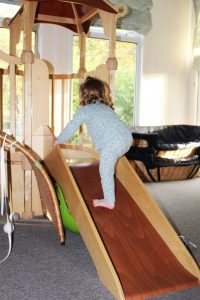

Supporting Adventurous Play
By allowing measures risks we are making our children more aware of their surroundings and abilities. Our aim is to let them find their limitations themselves instead of preventing learning opportunities. We often hear the words 'be careful' thrown around, but by simply changing our language we can help our children achieve their goals more safely. Here's some ways we can use language to encourage our toddlers and children with new tasks-
- 'Stay focused on what you’re doing.'
- 'Take your time'
- 'Find more space/do you need more space'
- 'Do you feel stable/balanced/safe'
- 'I’m here if you need me.'
- 'What could you do differently?'
The space and freedom that comes with our outdoor setting allows children to hone in on their motor skills, build their muscles and indulge in their natural curiosity. In our toddler room garden we have created a separate area incorporating some trees for climbing, slopes and ropes with uneven surfaces. This is heavily supervised but allows the children to take more risks in a safe environment. It strengthens their resilience and prepares them for even more opportunities when they are able to go in the woods for forest school sessions when they turn 3. With support and the right environment there is no limit to the tasks they can accomplish.
'The more risks you allow children to take, the better they learn to take care of them selves'
 - Kayleigh
- Kayleigh
Toddler's Forest School Garden
Measured Risks and The Great Outdoors
Getting outdoors could not be more important right now, and the health benefits that come with it are not only beneficial but fundamental to our wellbeing. But are the youngest members of our society getting enough outdoor adventurous play? Recent studies suggest not. 85% of parents admit they would like their children to have more adventure, whilst 44% admit they played outside more as a child then their own children do. Indeed this is a sign of the times and sometimes children miss out on these opportunities due to safety worries.

At Inspirations you can rest assured that your children are getting more than their fair share of outdoor play. Our outdoor areas are of equal, if not more importance to our indoor spaces. The 2-3 age group is where our children are first introduced to a designated forest school area in addition to their outdoor area.
Our toddler room garden is an extension of their classroom, filled with repurposed objects and areas that support the many types of schemas as mentioned in the previous blog. There are balancing beams, planks, crates, small world areas to support interests, and many more. It is here we make use of the larger loose parts and ambiguous resources such as milk crates, planks and go kart wheels. We have an open doors policy so in all weathers our toddlers have access to the outdoors.
Raising Confident Learners
Not all children have easy access to nature, so it's important we offer this space from a young age. But why is it important for young children to experience adventurous play?
In 2019 we gained planning permission to extend our toddler room garden and build a Forest School Area. This zone is opened up with increased staffing and introduces the children to more adventurous play, with tracks, steps, netting, hills and trees to explore and climb.
Providing this access opens up valuable experiences they may not get elsewhere. As their brains are forming, growing and changing every minute these measured risks they are exposed to supports healthy boundaries and emotional and physical development. This purpose built area means children are using core muscles, with hills to mount and areas to climb. The uneven ground tests and strengthens their vestibular balance skills and coordination.
Whilst children navigate this recently developed area we encourage them to safely create their own boundaries, trial ways of movement, and learn to just keep trying. Instead of suggesting how to use the area, we as educators will avoid giving direction but instead ask open ended questions. 'I wonder where you'll go next?' or 'wow that looked really hard, and you didn't give up'. By focusing on questions and observations rather than just praise and direction we are building our toddlers inner confidence that sets them up for life.
By creating dens between the trees, growing lavender and scaling balance beams, having this little taste of adventure prepares our toddlers for Forest School when they move to Pre-school ....and beyond.






Being Two- What are Schemas?
Welcome to part two of our focus on Being Two. This week we take a look at schemas, what they are, how our toddler room supports them, and ways to support this at home.
Have you made a cup of tea today, switched a light on, picked a pen off the floor and moved it to a flat surface to avoid it rolling off again? Then you have used schemas today without even realising it.
 A schema, put simply is like a mental model, a set of instructions we act out in our brain based on what has been successful in the the past. Whilst we come across schemas every time we learn something brand new, as you can imagine this happens the most at 2 and 3 years old.
A schema, put simply is like a mental model, a set of instructions we act out in our brain based on what has been successful in the the past. Whilst we come across schemas every time we learn something brand new, as you can imagine this happens the most at 2 and 3 years old.
Our toddler room is a HUB of schemas and is filled with opportunities to create these brain connections.
If I hit this will it break?
Whilst in may appear our little ones are rampaging through rooms causing chaos perhaps it helps to change our perspective and remember they are simply creating cognitive blue prints that set them up for life.
What happens if i drop this? Does this bounce? If I hit this will it break?
The Main Types of Schemas
Below are some examples of Schemas and how they are supported within the provision:
- Transporting – Moving objects or themselves from place to place. Moving things
with their hands. Bags, pots, pans, containers, sad. - Rotation – Turn and rotate objects or themselves. Roll their bodies, playing with toys
that spin, twist, and turn or even ride bikes. They could use Tyres, Wheels, Cable
reels and cars to explore this interest. - Enclosing – Join lines or build structures with objects such as bricks, magnets, or
malleable materials to form enclosures/models. - Connecting – Joining things together, fastening or tying things. Separating or
disconnecting construction etc. - Positioning- Our loose parts ethos lends its self well to this schema, lining things up, ordering different sized objects.
- Enclosing or enveloping- There is always a large cardboard box on the go in our toddler room setting for the children to climb into. But this can also be seen with sand or soil or fabric.
- Transforming- Messy play- gloop, water trays, mark making



I have attached a link that details further Schemas and how you at home can support these at home.
http://www.flyingstart.uk.com/wp-content/uploads/2014/08/Schema.pdf

Being Two
This Month we are focusing on our middle room at nursery, the toddler room, also known as our Honeybees room. Being two is more commonly referred to as the ‘Dreaded Twos’ or ‘Terrible Twos’; a term we find very unjust and instead celebrate this age with the phrase ‘Terrific Twos'.
Terrific Twos
It is very easy to conclude that your Toddler is in the midst of the ‘Terrible two’s’ when they act up and try push your buttons, especially when you are faced with patience testing tantrums.
It is important to remember that they are experiencing so many emotions and ultimately navigating their way into becoming tiny humans. They do not mean to drive you to the bottle of wine sat in your fridge, they are just growing and learning whilst showing you who they are and that being two really is terrific.
Adventure and Independence
In our eyes being a two year-old is about adventure and independence, traits we
feel are continuing to shape them after the transition from Baby to Toddler.

The Toddler room, or the Honeybee’s room as we refer to it is set up to allow the above,
and is a large area both indoors and out to move around freely, with many areas of
provision to explore and investigate. Whilst these areas are being slowly destroyed by tiny
hands and feet, friendships are being formed, and language is continuing to develop by
using simple sentences to share feelings, experiences and thoughts. They become more
aware of others feelings, and they are starting to understand boundaries and routines, as
well as listening with interest and understanding simple questions.
Milestones - Potty Training
Being Two also comes with it's challenges and a certain milestone is often met during this
period of their lives… Potty Training! Early signs that they may be transitioning
to this stage include awareness and communication. From telling you that they have done
something in their nappy to expressing the urge to go, these are all clear indictors that the
time is right and you should go with it and know that we are always their to support you. Remember that children develop at their own pace and they may not be ready to be potty trained until later.

Here are some links to books and tips for support-
https://www.amazon.co.uk/s?k=potty+training+books+for+toddlers&crid=BLJ3UFJL3K9O&sprefix=potty+training+%2Caps%2C192&ref=nb_sb_ss_ts-doa-p_3_15


Children are not things to be moulded, but people to be unfolded- Jess Lair
Next week we will focus on the importance of schemas, with some tips to supporting young children's language development. In the meantime if you've had a tough day, you've passed bath time and skipped straight to bedtime, you're still doing a great job. Remember it is this age that children are making new connections in their brain, pushing boundaries and learning vocabulary at rapid speed. We have to give credit to them for all this multitasking, whilst keeping our silliness alive, reigniting our imagination, and providing daily entertainment.
Although there can be some hard times amongst the great times if we start to see the world through their perspective we might all agree that life as a toddler can be challenging but also very fun.
-Ashleigh
Loose Parts
Why do we use loose parts?
Loose parts are a significant segment of our ethos at Inspirations Nurseries. Before moving away from conventional toys, we did a lot of research into the benefits of using loose parts. Several education pedagogies use loose parts. Reggio Emilia and loose parts complement each other well; we use both at Inspirations. Both philosophies support open ended play using natural resources, imagination, and creativity. When children are given opportunities to engage in free play with little adult direction, they are able to explore freely with creativity and expression, because there are no limitations or expectations.

What are Loose Parts?
Loose parts are open ended materials that can be moved around, designed, and redesigned. They create opportunities to use our imaginations and discover new ideas. Conventional toys are fixed for the one purpose they were made for, whereas loose parts are open ended and can be used for a variety of things. A plastic car can only be a car. A stick could be a magic wand or a person or you could use a number of them to make a house… the possibilities are endless. Ask any parent how long their children will play with the cardboard box a toy comes in on their birthdays. Loose parts can be found anywhere. How many of us remember going to the beach and collecting shells and stones and making patterns with them? You can find loose parts in the house, in the garden or on a walk. Loose parts include both manufactured and natural resources. These can include stones, pinecones, rings, balls, blocks, boxes, leaves and even nuts and bolts.


Endless Possibilities
For outdoor play, we provide a variety of large loose parts such as tyres of different sizes, milk crates, planks of wood, cable reels etc. In our baby rooms, we use a variety of loose parts to support schemas; we use things like curtain rings to hang on mug trees, balls to post through holes, tyres to encourage rolling. Toddlers can then use slightly smaller loose parts such as pebbles to create patterns and smaller wood slices for counting. Preschool are able to use more intricate loose parts such as beads, small tiles and items they find on forest school.
The founder of the Reggio Emilia Philosophy said...
“Children need the freedom to appreciate the infinite resources of their hands, their eyes and their ears, the resources of forms, materials, sounds and colours”.
-Kayleigh
See loose parts in action in our Pre-School room here- https://youtu.be/Nngfh6Uj-yw
